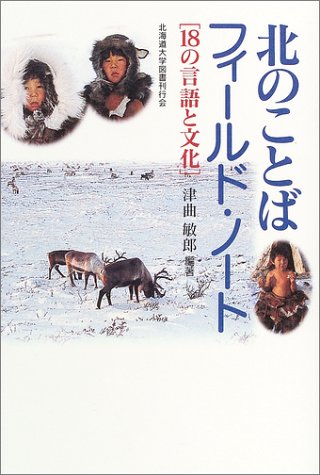14 0 0 0 OA ウデヘ語の手引き : こんにちは! ウデヘ語で話しましょう!
- 著者
- 津曲 敏郎 小林 香与 葛西 香子
- 出版者
- 北海道大学大学院文学研究科
- 巻号頁・発行日
- pp.1-25, 2006-08-31
津曲敏郎著; 小林香与協力; 葛西香子挿画, ウデヘ語の手引き : こんにちは! ウデヘ語で話しましょう! = Baagdifi! Udiemeji dianazafi!. 北海道大学文学研究科, 2006, 25p.
8 0 0 0 OA サハリンの言語世界 : 単語借用から見る
- 著者
- 津曲 敏郎
- 出版者
- 北海道大学大学院文学研究科
- 雑誌
- サハリンの言語世界 : 北大文学研究科公開シンポジウム報告書
- 巻号頁・発行日
- pp.1-10, 2009-03-08
本稿ではまずサハリンの言語状況を概観し、特に近年のウイルタ語をめぐる動きを紹介する。次にサハリンの先住民言語の間に見られる単語の相互借用について、先行研究からいくつかの例を紹介するとともに、あらたな事例を提供する。最後に、単語借用以外の文法面や口頭文芸においても影響関係が見られることにふれ、「言語地域」としてのサハリンの重要性を指摘する。
5 0 0 0 OA Nisăn Saman i Bithe における満州語詩の分析
- 著者
- 津曲 敏郎
- 出版者
- 北海道大學文學部
- 雑誌
- 北海道大學文學部紀要 (ISSN:04376668)
- 巻号頁・発行日
- vol.28, no.1, pp.61-104, 1980-01-31
2 0 0 0 OA ツングース語と上代日本語の文法上の類似点
- 著者
- 津曲 敏郎
- 出版者
- 国際日本文化研究センター
- 雑誌
- 日本語系統論の現在Perspectives on the Origins of the Japanese Language = Perspectives on the Origins of the Japanese Language (ISSN:13466585)
- 巻号頁・発行日
- vol.31, pp.237-247, 2003-12-26
1 0 0 0 北のことばフィールド・ノート : 18の言語と文化
- 著者
- 津曲敏郎編著
- 出版者
- 北海道大学図書刊行会
- 巻号頁・発行日
- 2003
1 0 0 0 OA 中国のツングース諸語
- 著者
- 津曲 敏郎 ツマガリ トシロウ Tsumagari Toshiro
- 出版者
- 国立民族学博物館
- 雑誌
- 国立民族学博物館調査報告 (ISSN:13406787)
- 巻号頁・発行日
- vol.39, pp.213-222, 2003-06-30
- 著者
- 津曲 敏郎 Kanchuga Aleksandr Aleksandrovich
- 出版者
- 北海道大学大学院文学研究科北方研究教育センター = Center for Northern Humanities, Graduate School of Letters, Hokkaido University
- 雑誌
- 北方人文研究 (ISSN:1882773X)
- 巻号頁・発行日
- no.4, pp.75-93, 2011-03
ここに紹介するのは、A.カンチュガ氏によるウデヘ語自伝テキスト第2巻に収められた民話(nima ku)の1篇である。原著者自身によるロシア字表記と録音をもとに、ローマ字音韻表記にあらため、文法分析と英訳を加えた。話のあらすじは次のとおり:ソロモという若者が嫁をもらったが、この嫁の正体はキツネで、あるとき夫を槍で刺し殺し、棺に入れて川に流す。棺は途中二度にわたり、下流に住む女の岸に流れ着くが、いずれもかかわりを嫌った女たちによって流れに押し戻されてしまう。三度目にたどり着いた岸で、タウシマという女に引き上げられるが、棺の中には髪の毛と小指しか残っていなかった。彼女はみずからシャーマンの儀式を行って、三日後に若者の身体と命を取り戻す。二人は一緒に暮らし始め、やがて結婚して、ソロモの両親のいる故郷の上流に向かって漕ぎ出す。途中で例の二人の女のもとに寄るが、事情を知って悔んだ女たちはそれぞれ首をくくってしまう。故郷の近くでもとの妻であるキツネに出会い、彼女がソロモの幸せを願いながら両親の面倒を見ていたことを知る。タウシマとともに両親のもとに帰り、四人で暮らし始める。ソロモとタウシマは長生きしてたくさんの子どもに恵まれた。
1 0 0 0 IR セイウチの長い旅--言語学的考察
- 著者
- 津曲 敏郎
- 出版者
- 北海道大学大学院文学研究科北方研究教育センター = Center for Northern Humanities, Graduate School of Letters, Hokkaido University
- 雑誌
- 北方人文研究 (ISSN:1882773X)
- 巻号頁・発行日
- no.3, pp.45-57, 2010-03
In the historical sites of the Okhotsk culture in Hokkaido, some artifacts made of walrus tusk have been found. The fact tells us that there was the walrus tusk trade between Chukchi-Kamchatka and southern area including Sakhalin and Hokkaido. Actually, the trade extended to China, and continued from the Middle Ages until the early 20th century. The present paper is an attempt to trace the route of the journey of walrus linguistically. As a tentative result, a Chukchi word for 'walrus' was borrowed by Even with changing the meaning into 'tusk', and then it spread to most of the Tungusic languages. The Uilta word for 'walrus', which may be a doublet of the word for 'tusk', was possibly introduced into Nivkh and Sakhalin Ainu. Then the Nivkh form for 'walrus' was brought into other Amur Tungusic. Though much more evidence is needed for our discussion, it may hopefully exemplify that linguistic data, as well as archeological materials, may serve as a powerful tool to trace the spread of culture.北海道のオホーツク文化の遺跡からセイウチの牙製とみられる彫像が出土しているが、このことからセイウチの棲息地であるチュクチ・カムチャツカ地域との間に、かつてセイウチの牙の交易ルートがあったことが想定されている。人とモノの流れがあったところに、ことばの行き来もまたあったはずである。特にセイウチのような棲息域の限られた動物であれば、交易品として珍重されたその牙とともに、セイウチや牙を表わす単語もまた北から南へと伝えられたに違いない。本稿はセイウチの旅を言語学的に跡付ける試みである。出発点としてチュクチ語の「セイウチ」をあらわす語が、隣接するエウェン語に「牙」の意味で取り入れられたことを想定する。この語はエウェンキー語を経て、アムール流域のツングース諸語に広がった。これがサハリンのウイルタ語に再び「セイウチ」を表わす語として入り、そこからニブフ語とサハリン・アイヌ語にも伝わったと考えられる。ニブフ語の「セイウチ」はさらにアムール流域のツングース諸語の「セイウチ」の直接の語源となっている。このように、特にサハリン・アムール地域の言語間の関係はなかなかに複雑であり、これをもってセイウチをめぐる語の借用関係が解明されたとは言えない。本稿では、文化の伝播を考える上で言語的データが重要な意味をもつことを例証し、あわせてそうした言語が失われつつある現実にも注意を喚起する。
1 0 0 0 OA 『北方言語研究』創刊に寄せて
- 著者
- 津曲 敏郎
- 出版者
- 北海道大学大学院文学研究科
- 雑誌
- 北方言語研究 (ISSN:21857121)
- 巻号頁・発行日
- vol.1, pp.i-iv, 2011-03-25
- 著者
- 津曲 敏郎
- 出版者
- ぎょうせい
- 雑誌
- 国文学 : 解釈と鑑賞 (ISSN:03869911)
- 巻号頁・発行日
- vol.75, no.1, pp.78-83, 2010-01
